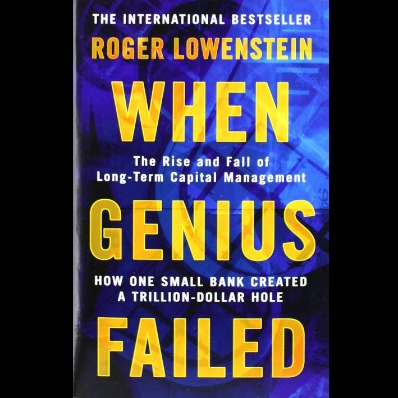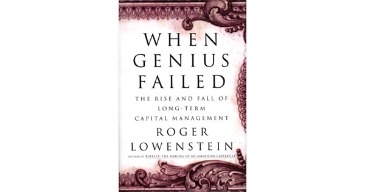When Genius Failed
Table of Contents Heading
- Video Summaries Of When Genius Failed
- Diversification Does Not Help In Crisis Everything Falls Down Simultaneously.
- Key Learning From when Genius Failed
- Spread The Wealth
- Reader Interactions
The banks, on the other hand, had no control over where their money was spent. After all, LTCM were the “experts.” Blinded by profit potential, they failed to examine and evaluate the true economic strength – or weakness – of the hedge fund. This famous fable on the dangers of hubris can be easily applied to the story of Long-Term Capital Management, a huge hedge fund which dominated the financial markets in the 1990s. Like Icarus, they found themselves riding high, with profits through the roof, and yet they also went too far.

I am not especially interested in hedge funds or Wall Street. I was interested in a current non-fiction about business and especially some dramatic turn of business events; I liked Barbarians at the Gate. This has about 2/3 of the movement, pace, and drama of that, or perhaps half, but it’s enough.
Video Summaries Of When Genius Failed
But the thing that intrigued me the most is that it does not appear that the Wall Street banks learned a lasting lesson from the debacle. In order to avoid systemic losses throughout the financial system, there were 14 banks that ultimately bailed out the LTCM fund, including firms like Lehman Brothers, Merrill Lynch, Chase, Goldman Sachs, Salomon Smith Barney, UBS, etc. It does make you wonder if this cycle of greed and fear is bound to repeat itself, or if a new paradigm will emerge among financial institutions and regulators to prevent these meltdowns in the future. Couldn’t put it down – the folly of over leveraged bond market trading was just too interesting for me to handle. The book is on Long Term Capital Management, containing a bunch of math, computer and financial wizards who wanted to tame the market using statuses and probability. Add in two noble prize winners, champion traders and an ex-Federal Banker, and you have one of the most illustrious funds. “They had forgotten the human factor.” Sometimes ‘vulgar Marxist’ accounts of economics can be eerily similar to efficient markets theory because they assume a sort of natural outcome of exploitation and trading.

He decided to start his own hedge fund that would be unregulated and available only to the rich. Most hedge funds are conservative; they use leverage in order to create market neutral portfolios.
International markets were grinding to a halt during this period and the Fed was running out of time before an all-out meltdown was potentially about to occur. Ultimately, McDonough was able to get 14 banks to wire $3.65 billion in bailout funds to LTCM. While all LTCM partners were financially wiped out completely, initial investors managed to recoup a small portion of their original investment , even though the tally of total losses reached approximately $4.6 billion. Once the bailout was complete, it took a few years for the fund to liquidate its gargantuan number of positions and for the banks to get their multi-billion dollar bailout paid back in full. The modern financial world is a 747 with one engine, no backup systems, and crew more than a bit unclear on how it works. Everything must work right all the time or there is a crash with little in between.
Diversification Does Not Help In Crisis Everything Falls Down Simultaneously.
The rise over the last two decades of a powerful new class of billionaire financiers marks a singular shift in the American economic and political landscape. Their vast reserves of concentrated wealth have allowed a small group of big winners to write their own rules of capitalism and public policy. A real-life thriller about the most tumultuous period in America’s financial history by an acclaimed New York Times reporter. Andrew Ross Sorkin delivers the first true, behind-the-scenes, moment-by-moment account of how the greatest financial crisis since the Great Depression developed into a global tsunami. It was wonderful to be young and working on Wall Street in the 1980s – never had so many 24-year-olds made so much money in so little time. In this shrewd and wickedly funny audiobook, Michael Lewis describes an astonishing era and his own rake’s progress through a powerful investment bank.
When times were good for LTCM, all the investment banks wanted a piece of the action. They pushed to lend the fund more capital with which to trade. They competed to earn commissions from clearing LTCM’s trades. But in the end, they were asked to step in and save it from destabilising the entire financial system, just as the UK Government was forced to intervene to prevent the collapse of Northern Rock doing the same. The story of the collapse of the hedge fund Long Term Capital Management is recounted in Roger Lowenstein’s compelling book. In this business classic–now with a new Afterword in which the author draws parallels to the recent financial crisis–Roger Lowenstein captures the gripping roller-coaster ride of Long-Term Capital Management.

However, investors frequently forget that leverage is a double-edged sword. It pushes the return on equity during upside; however, it hammers down the same return on equity during downside. The short life of six year of LTCM is a lesson for all the investors around the world.
Will LTCM’s resolution make the too-big-to-fail problem even worse? Perhaps with time we will have a clearer sense if the benefits of the Fed’s role in the LTCM resolution outweigh potential costs. For now, enjoy Lowenstein’s fable but come up with your own more satisfying moral. Losing focus from your competitive advantage can be costly. LTCM compounded its problems by shifting away from areas where it benefited from comparative advantage. In response to the rising competition, partners in the firm moved from bond markets where many had spent their entire careers and had developed significant expertise, to stock markets where they had much less experience. For example, the firm made sizable bets on the completion of certain mergers, even though these markets did not lend themselves to LTCM’s analysis or skills.
From best-selling author, investment expert, and Wall Street theoretician Jack Schwager comes a behind-the-scenes look at the world of hedge funds, from 15 traders who’ve consistently beaten the markets. The book tells the story of a darling of the Wall Street in the 1990s, the firm that attracted awe of investors, financial regulators, academia and business leaders in general. The firm which was called Long-Term Capital Management was established and ran by the cream of the cream in the U.S. financial industry and financial education. Its investment placements were based on sophisticated mathematical models developed largely by the founders themselves. The partners managed to raise huge amount of investment in a very short time (because everyone else was blindfolded by the partners’ credentials) making it one of the most successful start-ups in history. At certain moments, the firm was managing rather astronomical volumes of investments. LTCM earned great returns in the early years through the use of leverage, derivatives and easy credit terms from its banks.
Key Learning From when Genius Failed
However, in reality, their losses reached $533 million. Their debts and lack of capital meant that the firm needed to sell quickly to stay solvent.
I was hoping for some more context – you don’t get a good sense for what was happening in the economy at large during this time –but as far as LTCM’s story is concerned, you get the full scoop. If you don’t much care about what happened to Long Term Capital Management, you won’t mush care for this book – but if you’ve even a passing interest, it’s a surprisingly assessable and pretty entertaining account. LTCM began as the “largest startup of all time”; the first round of fundraising weighed in at $1.25B. Started by John Meriwether and a group of quants, LTCM’s strategy was to find arbitrage opportunities and magnify them using a tremendous amount of leverage. Lowenstein does a pretty good job of explaining LTCM’s various trading strategies. As the title suggests, “When Genius Fails” is about the “Rise and Fall of Long-Term Capital Management.” Don’t expect to learn why the economy itself went to shit, causing LTCM to lose ungodly sums of money.
I was too busy covering the tech frenzy in Silicon Valley for Red Herring Magazine. When our book was in the publishing pipeline word got back to me from an editor at Fortune magazine that the author of this book had started a book about the tech bubble, but changed course when he found out about our book.
Spread The Wealth
LTCM got around this by use of complex derivatives that served as proxies for the actual stock that are not governed by that rule. Not only is “When Genius Failed” a great read, it accurately foreshadows the “weapons of mass destruction” risks, to quote Warren Buffett, that would lead to the subprime meltdown and Great Recession. Reading this book, along with Kindleberger’s “Manias, Panics, and Crashes” allowed me to foresee the Great Recession, steer clear, and avoid damage. It also helped me to better understand booms and busts in my own upcoming book “Cleantech Con Artists.” The book charts a chronological course through the history of LTCM, from its start-up, through its ascendancy, to its fall and implosion.
I highly recommend this book to anyone interested in business and finance. The boldness of LTCM’s management wasn’t what surprised me the most. It was that almost the exact same scenario – this time in CMBS instead of bonds and currencies – repeated itself less than ten years later in the crash of 2008. As for the writing, Lowenstein masterfully aggregates multiple accounts of the events and leaves the reader utterly engrossed. I have given it 4 stars because the book misses more explanations to make it accessible to the broad public and the layperson. I would call the book quite “heavy” in strong quotes and statements that would take time and effort to properly digest all the relations and implications , definitely very relevant reminder in today’s world.
Our final book summarys will investigate the mistakes that ultimately led to LTCM’s downfall. Despite knowing very little about these products, they invested very heavily, as the models told them that everything would work out. So they gave the strategy a shot, and in doing so added more risk. They began investing in paired shares – essentially different stocks in the same company. For example, they invested in Royal Dutch Petroleum and Shell Transport England, both of which comprised the international conglomerate Royal Dutch Shell. In times of uncertainty and insecurity, the normal thing to do would be to invest in bonds, which, although not very profitable, are very secure. This academic approach was a major lure for investors, and contributed to LTCM’s enormous success.
After the bailout of South Korea by IMF, the Asian markets stabilised. In May 1998, the Central Bank of Russia indicated towards a potential debt crisis and tripled its interest rate to halt flight of capital. The spreads widened to unforeseen levels and volatility increased substantially. As a result, LTCM suffered enormous losses, far more than their predictions. Unwinding positions became increasingly difficult in times of panic. In order to secure funding, LTCM had to disclose their positions to banks, the leaking of which led to exit by investors and further widening of spreads.
Reader Interactions
LTCM episode is a glaring proof that no one is above errors. Investing is more of an art where once the basic financial numbers are obtained; rest is dependent upon the investor’s subjective judgment and common sense. Therefore, it is advised that investors should not overemphasize on diversification and keep the number of stocks in their portfolio limited. The fund was finally bailed out by intervention of Federal Reserve in 1998 and was dissolved in 2000. At its high point in 1998, it had USD 4.6 billion in partner’s equity. However, its total asset size was much larger than USD 4.6 billion. LTCM used to get heavily leveraged directly by using the credit lines extended by almost all the Wall Street institutions and indirectly by taking exposure in derivatives including credit default swaps .
However, markets may not recognize the aberration in pricing of these stocks immediately after an investor buys them. Moreover, there may be many months or years before a good performing company with cheap share price is recognized by other market participants and its price increases in value.
Finally, even if such a predictive market simulation could be built, it might not be able to recognize a regime shift in time for the information to do any good. The 1987 stock market crash happened in a very short period of time, for example. In theory a model could be built that would predict market regime shift. If we had unlimited amounts of computing power and the ability to simulate humans, with their judgment, fear and greed, we could build a simulation that would perfectly model market behavior. When such a synthetic market got certain inputs, like the Russian bond default, the market will become chaotic.
- Such periods creates feelings of frustration and self-doubt in investors and many times, makes them take wrong decisions exact at precisely wrong times.
- A stock option derives its value from the underlying price of a stock or stock index.
- Meriwether was slapped on the wrist with a suspension and fine, and although Buffett eventually took back Meriwether in a demoted role, ultimately the trader was viewed as tainted goods so he left to start LTCM in 1993.
- Lowenstein does a nice job in pacing the story and I recommend reading the book for these reasons alone.
- Just as inflation was changing the way bonds were sold and held, Meriwether entered the field in the mid 1970’s as a bond trader.
The story of this fund’s collapse proves that markets are not efficient. It is a lesson that precision calculations in the world of finance, no matter how correct or ingenious, are no match for human irrationality when panic strikes. Amplifying the unforeseen risk of the fund were human errors made by the principals. The firm’s superior performance depended on incredible leverage , but that leverage also led to LTCM’s demise when the margin calls hit. One disadvantage of this book is that it focuses so much on the people involved that it sacrifices explanation of the market forces behind the Asian currency crisis. I felt that some chapters contained too many dry details on the interaction between the LTCM principals and the banks. The advantage of its focus on people is that the reader can see many of today’s Wall Street icons in action.
Big Idea #2: Ltcm Leveraged Heavily In Order To Maximize Their Profits
Investors panicked and sought the safety of buying US treasury bonds in huge quantities. This threw out LTCM’s trading models as bond prices diverged. This book is aptly named as it delivers just what the title implies. Young John Meriwether began his career as a high school math teacher. After only one year of teaching he enrolled in the University of Chicago and began work to attain a business degree after which he was hired by the investment giant, Solomon Bros. Just as inflation was changing the way bonds were sold and held, Meriwether entered the field in the mid 1970’s as a bond trader. Being one to adapt to a situation he found a niche for himself working within a division of Solomon and with other egghead intellectuals or quants, if you will.

